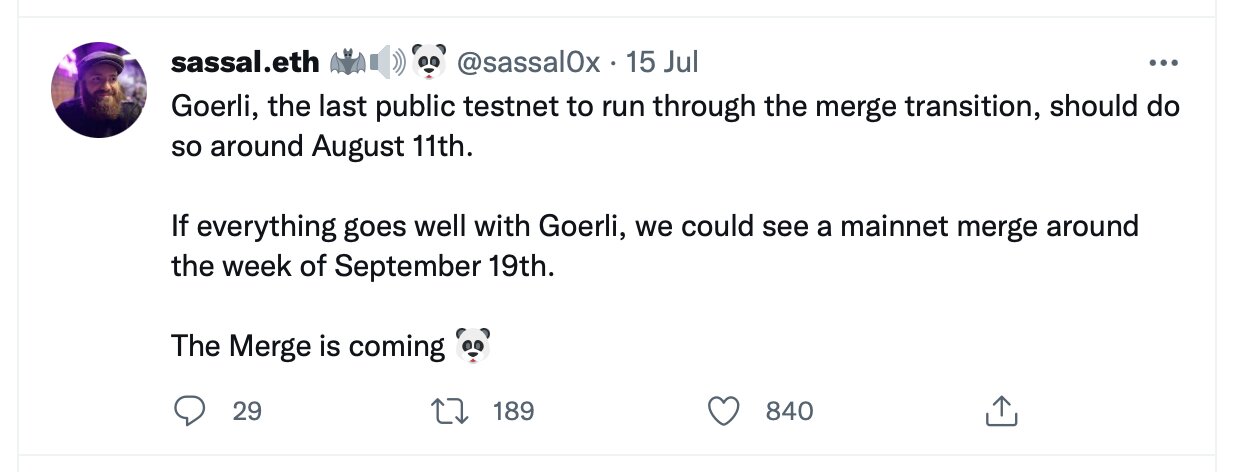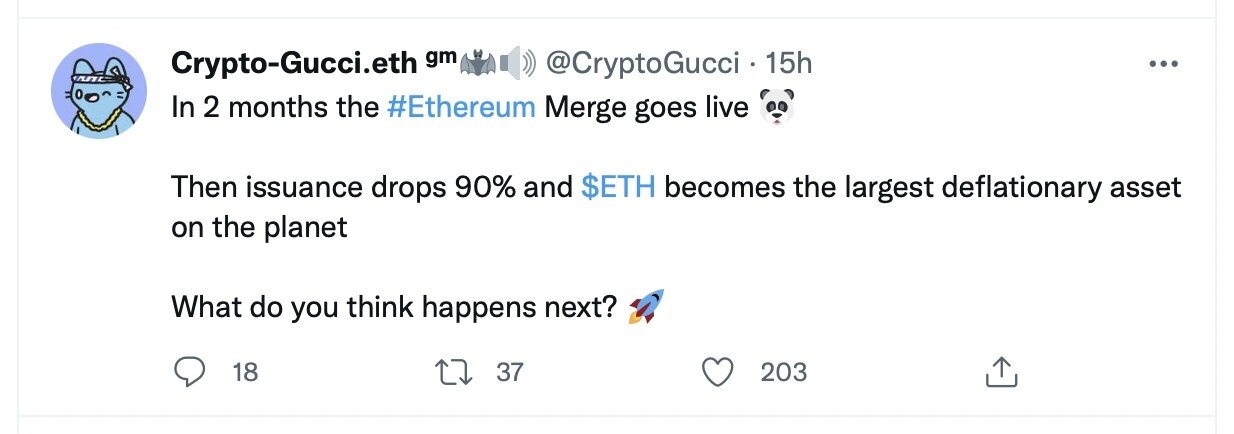- >News
- >Ethereum Surges After the Merge Receives Soft Launch Date
Ethereum Surges After the Merge Receives Soft Launch Date
Ethereum holders can finally see the light at the end of the proverbial tunnel. After years of waiting, developers have given the much-anticipated Merge a soft launch date, with the shift to proof-of-stake now penciled in for the week beginning September 19. This piece of information has set the market for ETH all aflutter, with the altcoin rising from roughly $1,080 on July 14 — when the date was provisionally set — to $1,560 as of writing.
This is a rise of 44%, signaling what kind of bullishness awaits Ethereum once the merge with its proof-of-stake Beacon Chain is finally completed in a couple of months (or so). Indeed, with only one testnet left to launch before the Merge can go ahead, it really does look like the event is finally going ahead.
Of course, switching to a proof-of-stake consensus mechanism won’t mean that Ethereum’s fees and throughput will improve dramatically overnight. Nonetheless, the end of mining will reduce the issuance of new ETH, something which will squeeze the supply of the cryptocurrency and potentially push up its price.
Ethereum Is One Step Closer to Making the Merge a Reality
The latest update in the ongoing Merge saga arrived on Thursday July 14, when the Ethereum Foundation’s Tim Beiko revealed that developers had agreed on setting the week of September 19 as the provisional window for the Merge to happen.
This timeline is dependent on one thing, namely another successful testnet merge. After a number of previous trials with various testnets, Ethereum developers are now scheduled to merge the Goerli testnet with its own version of the Beacon Chain on August 11. From there they’ll test and play around with how Goerli — which is basically a mirror of Ethereum itself — works with a PoS consensus mechanism.
Goerli is the final public testnet, meaning that once work on it is completed, developers can turn to the actual Ethereum network.
Source: Twitter
As stated above, the solidification of this roadmap — and the progress developers have made in working on previous testnets — has reignited market bullishness for Ethereum. It’s currently up by just over 50% in a week, according to CoinGecko, and the confirmation of September 19 as the Merge’s actual date will likely send it even higher.
Much of its future gains will, of course, be the retreading of lost ground, with ETH having hit an all-time of $4,878 last September. Still, the successful completion of the Merge could provide the market with the confidence to pump the altcoin back to these former heights, with its current price some 67% below its record.
Part of any future surge will also be driven by one important characteristic of the Merge, which is its elimination of proof-of-work mining. As with Bitcoin, mining results in the issuance of new coins, with Ethereum’s total supply growing from 109.1 million ETH at the beginning of 2020 to 119.75 million ETH today. This equates to a growth rate of about 9.7% since January 2020, with Ethereum’s supply growing on average at about 2.56% per year.
However, the shift to proof-of-stake will reportedly reduce issuance of new coins by around 90%. When combined with the fact that staking will encourage holders to lock up their ETH, Ethereum could indeed become something like a deflationary currency, rivaling Bitcoin as a digital store of value.
Source: Twitter
Needless to say, plenty of work remains to be done, with developers and Ethereum community members taking great pains to affirm that the September 19 timeline “isn’t final,” and should be regarded merely as a “planning timeline.” Likewise, at least some people outside of the community continue to take a detached attitude to whether developers can actually stick to the current roadmap, given that the Merge has been beset by numerous delays in the past.
Priced In? Scalability Now?
That said, with only one testnet left to run, there’s less scope for large delays, so a big postponement does seem unlikely right now. However, there does remain at least a couple unanswered questions regarding the Merge, beginning with whether it has already been ‘priced in’ by the market.
In other words, has the impending Merge already pushed ETH’s price as far as it’s likely to go, even after it’s completed? Opinion is somewhat mixed on this question, but most commentators and analysts seem to believe it isn’t fully priced in, yet.
This makes sense, given that ethereum’s price has risen by bigger percentages in the past week or so than bitcoin’s. Its above-average gains are the market pricing in the Merge, with ETH continuing to rise as we type these words. And it’s likely that much of the pricing-in won’t happen until the Merge is successfully completed, given how many delays the shift has suffered and how some investors may prefer to ‘wait and see’ before buying.
Another question about the Merge is whether it will improve Ethereum’s scalability in the short-term. The answer is that it won’t make a substantial difference immediately, while it also won’t make a difference to transaction fees, which have often been a bane on the existence of Ethereum users over the past couple of years. As such, layer-two solutions such as Polygon will continue being a big part of the cryptocurrency ecosystem.
Even so, the shift to PoS will enable the establishment of ‘committees,’ which in turn enable the Ethereum blockchain to separate into shards. This upgrade isn’t due until next year at the earliest, but the ability to shard will ultimately enable different parts of the Ethereum blockchain to validate different transactions in parallel, something which will increase its scalability considerably in the long run.
While this seems a long way off, the progress that has been made towards realizing the Merge suggests that sharding will come sooner or later. And with Ethereum already being the biggest layer-one blockchain in terms of value locked in, the arrival of these two big upgrades should cement its position even further. All of which implies that, at $1,560, ethereum is probably undervalued very heavily right now.




